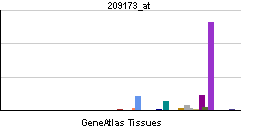AGR2
| Anterior gradient homolog 2 (Xenopus laevis) | |||||
|---|---|---|---|---|---|
| Identifiers | |||||
| Symbols | AGR2 ; AG2; GOB-4; HAG-2; XAG-2 | ||||
| External IDs | Template:OMIM5 Template:MGI HomoloGene: 4674 | ||||
| |||||
| RNA expression pattern | |||||
 | |||||
| More reference expression data | |||||
| Orthologs | |||||
| Template:GNF Ortholog box | |||||
| Species | Human | Mouse | |||
| Entrez | n/a | n/a | |||
| Ensembl | n/a | n/a | |||
| UniProt | n/a | n/a | |||
| RefSeq (mRNA) | n/a | n/a | |||
| RefSeq (protein) | n/a | n/a | |||
| Location (UCSC) | n/a | n/a | |||
| PubMed search | n/a | n/a | |||
Anterior gradient homolog 2 (Xenopus laevis), also known as AGR2, is a human gene.[1]
References
Further reading
- Maruyama K, Sugano S (1994). "Oligo-capping: a simple method to replace the cap structure of eukaryotic mRNAs with oligoribonucleotides". Gene. 138 (1–2): 171–4. PMID 8125298.
- Suzuki Y, Yoshitomo-Nakagawa K, Maruyama K; et al. (1997). "Construction and characterization of a full length-enriched and a 5'-end-enriched cDNA library". Gene. 200 (1–2): 149–56. PMID 9373149.
- Thompson DA, Weigel RJ (1998). "hAG-2, the human homologue of the Xenopus laevis cement gland gene XAG-2, is coexpressed with estrogen receptor in breast cancer cell lines". Biochem. Biophys. Res. Commun. 251 (1): 111–6. doi:10.1006/bbrc.1998.9440. PMID 9790916.
- Petek E, Windpassinger C, Egger H; et al. (2000). "Localization of the human anterior gradient-2 gene (AGR2) to chromosome band 7p21.3 by radiation hybrid mapping and fluorescencein situ hybridisation". Cytogenet. Cell Genet. 89 (3–4): 141–2. PMID 10965104.
- Strausberg RL, Feingold EA, Grouse LH; et al. (2003). "Generation and initial analysis of more than 15,000 full-length human and mouse cDNA sequences". Proc. Natl. Acad. Sci. U.S.A. 99 (26): 16899–903. doi:10.1073/pnas.242603899. PMID 12477932.
- Fletcher GC, Patel S, Tyson K; et al. (2003). "hAG-2 and hAG-3, human homologues of genes involved in differentiation, are associated with oestrogen receptor-positive breast tumours and interact with metastasis gene C4.4a and dystroglycan". Br. J. Cancer. 88 (4): 579–85. doi:10.1038/sj.bjc.6600740. PMID 12592373.
- Scherer SW, Cheung J, MacDonald JR; et al. (2003). "Human chromosome 7: DNA sequence and biology". Science. 300 (5620): 767–72. doi:10.1126/science.1083423. PMID 12690205.
- Hillier LW, Fulton RS, Fulton LA; et al. (2003). "The DNA sequence of human chromosome 7". Nature. 424 (6945): 157–64. doi:10.1038/nature01782. PMID 12853948.
- Clark HF, Gurney AL, Abaya E; et al. (2003). "The secreted protein discovery initiative (SPDI), a large-scale effort to identify novel human secreted and transmembrane proteins: a bioinformatics assessment". Genome Res. 13 (10): 2265–70. doi:10.1101/gr.1293003. PMID 12975309.
- Zhang Z, Henzel WJ (2005). "Signal peptide prediction based on analysis of experimentally verified cleavage sites". Protein Sci. 13 (10): 2819–24. doi:10.1110/ps.04682504. PMID 15340161.
- Gerhard DS, Wagner L, Feingold EA; et al. (2004). "The status, quality, and expansion of the NIH full-length cDNA project: the Mammalian Gene Collection (MGC)". Genome Res. 14 (10B): 2121–7. doi:10.1101/gr.2596504. PMID 15489334.
- Zhang JS, Gong A, Cheville JC; et al. (2005). "AGR2, an androgen-inducible secretory protein overexpressed in prostate cancer". Genes Chromosomes Cancer. 43 (3): 249–59. doi:10.1002/gcc.20188. PMID 15834940.
- Persson S, Rosenquist M, Knoblach B; et al. (2005). "Diversity of the protein disulfide isomerase family: identification of breast tumor induced Hag2 and Hag3 as novel members of the protein family". Mol. Phylogenet. Evol. 36 (3): 734–40. doi:10.1016/j.ympev.2005.04.002. PMID 15935701.
- Stelzl U, Worm U, Lalowski M; et al. (2005). "A human protein-protein interaction network: a resource for annotating the proteome". Cell. 122 (6): 957–68. doi:10.1016/j.cell.2005.08.029. PMID 16169070.
- Rual JF, Venkatesan K, Hao T; et al. (2005). "Towards a proteome-scale map of the human protein-protein interaction network". Nature. 437 (7062): 1173–8. doi:10.1038/nature04209. PMID 16189514.
- Fritzsche FR, Dahl E, Pahl S; et al. (2006). "Prognostic relevance of AGR2 expression in breast cancer". Clin. Cancer Res. 12 (6): 1728–34. doi:10.1158/1078-0432.CCR-05-2057. PMID 16551856.
- Lim J, Hao T, Shaw C; et al. (2006). "A protein-protein interaction network for human inherited ataxias and disorders of Purkinje cell degeneration". Cell. 125 (4): 801–14. doi:10.1016/j.cell.2006.03.032. PMID 16713569.
- Zhang Y, Forootan SS, Liu D; et al. (2007). "Increased expression of anterior gradient-2 is significantly associated with poor survival of prostate cancer patients". Prostate Cancer Prostatic Dis. 10 (3): 293–300. doi:10.1038/sj.pcan.4500960. PMID 17457305.
| This protein-related article is a stub. You can help Wikipedia by expanding it. |